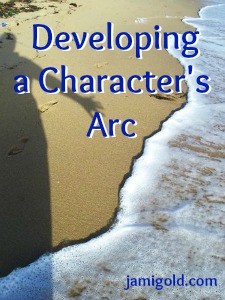Today, Janice Hardy shares her revision advice on how to include the right amount of backstory. Too much slows the pace, and too little can leave readers confused. Her tips help us avoid the issue of slow pacing, learn how to hide backstory, and identify when we need more.
Pin It
Read More
There are almost an infinite number of ways we can develop our story. As long as we end up with a finished book, our process works. And just like the variety found in the overall writing processes we might use, we have many options for how to come up with our protagonist’s arc as well.
Pin It
Read More
Our stories consist of many elements—from backstory to dialogue—that each contribute to our story. Yet we can overdo those elements with an information dump. How can we include the different elements while making sure we don’t cross over into Info Dump Land? Let’s talk options…
Pin It
Read More
My Elements of a Scene Checklist helps us identify whether a scene is truly necessary and contributing to our story by making sure it fulfills a story purpose. The same judgment criteria can apply to subplots as well. Let’s take a look at how can we make sure our tangents and subplots are adding to the story and not acting as a distraction.
Pin It
Read More
Many stories “strike out” with readers in the first chapter. So our opening pages are just as critical to sales as our book cover, title, back-cover blurb, etc. Let’s take a closer look at cliches to avoid and tips to make those pages work for us.
Pin It
Read More
If we write our story well, every aspect of the story will contribute to the overall picture and create an impression for the reader. There aren’t any unimportant details in a well-written story. And that means the careers for our characters shouldn’t be an afterthought either.
Pin It
Read More
Last year, I wrote a series of posts about a fabulous presentation by Michael Hauge on “Using Inner Conflict to Create Powerful Love Stories.” But the teachings I picked up from the presentation went far beyond being applicable only to romance. Blogger extraordinaire Janice Hardy was in the workshop with me, and […]
Pin It
Read More
Last time, we talked about using our characters’ strengths to develop their flaws. But I didn’t get a chance to talk about how we could figure out the matching flaw for a character strength. Many of you are probably familiar with the Myers Briggs test, a well-known test that labels people […]
Pin It
Read More
In my post last week asking if we can have too much voice, some great questions came up in the comments. I decided to turn them into “Ask Jami” blog posts rather than bury the answers in the comment string. Earlier, I shared ideas on how to use color-coding to check if […]
Pin It
Read More









